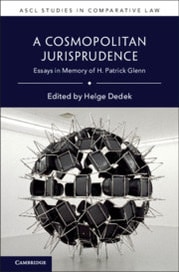Thinking well of traditions
February 23, 2023

[Editor’s note: this is the second of four blog posts featuring the volume “A Cosmopolitan Jurisprudence: Essays in Memory of Patrick Glenn, edited by Helge Dedek, Cambridge University Press, ASCL Studies in Comparative Law, 2022]
The most controversial theoretical contribution to comparative law by the polymathic Patrick Glenn in his Legal Traditions of the World was his effort to get us to think well of tradition(s). For him, the key to tradition is the idea of information, that which is brought from the past to the present, in a particular social context. It can include stories, concepts, beliefs, facts, symbols, values, political theories, heuristics and, if not actual institutions, at least ideas about institutional objectives, design and significance. The variety of information captured will increase as the tradition increases in size, each generation capturing its own understanding of the tradition. The pool of information captured by the adherents of a particular tradition cannot be entirely controlled, but a tradition stays alive through massaging i.e.- by being called on selectively (the massage is the message?) Above all, however, for Glenn, legal traditions do, can and should respect each other. Elaborating this argument was part of a project of building what he called ‘sustainable diversity in law’, a necessity for the peaceful coexistence of different ideas and peoples.
Realising such an aspiration is increasingly urgent as so many groups are currently reacting to globalisation by (re) emphasising connections with the past and appealing to supposedly long-standing distinctive religious and national bonds and identities. But it begs a series of questions. How far can tradition help to facilitate necessary changes rather than stand in their way? What happens to those who challenge tradition? When do traditions in fact respect each other, when do they instead seek to predominate?
Glenn tells us that major traditions achieve complexity because of their proven ability to hold together mutually inconsistent sub-traditions. But if it is intuitively plausible to think that the complexity of tradition makes necessary a tolerance of potentially conflicting ideas, at least some of the time, it is less obvious that the same applies to the relation between traditions. Glenn admits that a tradition can take specific measures to protect its underlying or basic elements, using means that range from a simple ethical obligation to remember, to instruments variously known as heresy, treason, or sedition. But he asserts nonetheless that the authority of tradition is persuasive only. It allows for dialogue and normative engagement, as opposed to hierarchical dominance.
Some of Glenn’s claims may depend more on definitional stops than on empirical findings. But if we are to make progress in assessing them (and further his admirable goals) we require more case studies of how in practice different traditions manage continuity and change, and the ways in which they deal with (other) internal and external challenges. One example of reconciling continuity and change under changing social circumstances is offered by the way the Jewish law tradition (one of those examined in detail by Glenn) revoked and/or reinterpreted the strict biblical rules about the cancellation of loans every seven years. The rabbis, following the suggestion of Hillel, crafted a loophole by introducing a document -the Pruzbul- that would accompany interest-free loans, stating that such loans were to be transferred to the courts. As the law of remission does not apply to loans within the public domain this ground-breaking institution benefited both borrowers and lenders. It meant that borrowers would still be able to access loans because lenders knew their money would be safe despite the arrival of Sabbatical year.
The issue- much fought over by different streams within Jewish tradition- is by what right Hillel sought to circumvent what appeared to be a clear Biblical prescription (one accompanied by a warning that people should not refrain from lending even if they knew they would not be repaid). The more conservative answer explains that, because of changes in where Jews were living at the time of Hillel’s ruling, the Biblical requirement to cancel debts was no longer binding. It was now only supported by Rabbinical authority and hence could be amended by that same authority. More, the change was intended to privilege the higher level-Biblical – necessity to ensure that loans continued to be forthcoming. More radical commentators tend instead to take Hillel’s action as an example of bold willingness to update tradition in the light of changing social needs. They treat his innovation as a purported precedent for similar bold interventions on other fronts which in their view are now crying out for reform. As for traditions being mutually respectful, for outside observers, the exact basis of Hillel’s action is less significant than for insiders. Depending on the starting points of rival traditions, they can be less than generous to this innovation – for example preferring to highlight the persistence of different rules about lending on interest to insiders as compared to outsiders. For some, Hillel’s creative skill in renewing the past in the present is characterised as Rabbinical casuistry in the service of proto capitalism.
